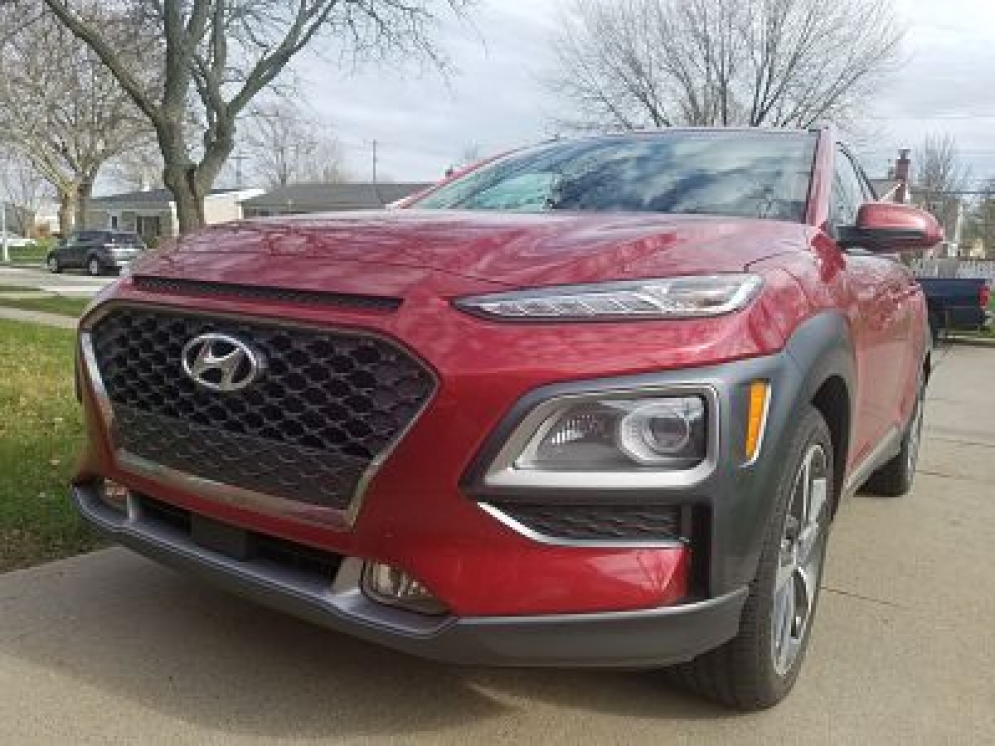HOW’S THE RIDE?
Two engines are offered on the Kona: One turbo, and one non-turbo. The standard engine, a 2.0-liter four cylinder, offers 147 hp and 132 lb.-ft. But I wholeheartedly recommend skipping this more sluggish option and going for the turbo engine.
My test vehicle featured the 1.6-liter, turbocharged 4-cylinder engine, paired with a 7-speed automatic transmission. Drive Mode Select lets you choose between Regular or Sport settings (once you experience it, you’ll want to stay in Sport whenever possible), and the numbers on this engine are 175 horsepower and 195 lb.-ft. of torque. In my experience, the Kona went 0-to-60 in under 7 seconds, which is battling for best in class.
The turbo engine offers lots of pep and is extremely agile, making this one sporty subcompact. Typically, I’m unimpressed with the drive in these subcompacts, but to my surprise the Kona offered a more enjoyable overall driving experience than most (or possibly all) of its competitors. The handling is top-notch, you never feel sluggish or slow, and the vehicle does everything you want it to do without delay.
The engine can be a bit noisy when you get moving, but it's not an unpleasant type of noise.
The Kona is also available in both FWD and AWD options. Adding AWD will also upgrade your rear suspension, which in turn will boost the overall handling of the Kona.
The overall positive experience of driving the Kona may be what sells it best, as its stock grows in coming years. It never struggles like some smaller crossovers can, and should win lots of converts from other subcompacts like the Honda HR-V, Toyota C-HR and Nissan Kicks.
TECHNOLOGY, SAFETY
One area where Hyundai doesn’t disappoint with the Kona is tech and safety, where you get a bevy of standard features to help improvement your entertainment and safety experience.
All Kona trim lines will include at least a 7-inch touchscreen, compatible with both Apple CarPlay and Android Auto for smartphone mirroring, as well as Bluetooth connectivity. Higher trim levels come with an 8-inch touchscreen. You get push button start, plus well-placed steering wheel controls for audio, phone and cruise control.
Among standard safety features on the Kona are: Anti-lock brakes, rearview monitor with parking guidance, automatic emergency braking, lane-keeping assist, and a driver-attention monitoring system, as well as a bevy of air bags, and a tire pressure monitoring system with individual tire indicator.
Other safety features you can add include: Lane change assist; blind spot and rear cross traffic collision warning and pedestrian detection.In higher trim levels, wireless phone charging is offered, as well as a heads-up display that is helpful for keeping your eyes on the road.
Overall, the infotainment system was user-friendly, and responded quite well to both touch commands and voice instructions. You can upgrade to a stout 315 watt sound system, including Infinity premium audio with Clari-Fi music restoration tech. A 90-day trial of Sirius satellite radio is included.
MPG
The official fuel mileage numbers on the Kona are 28 city/32 highway/30 combined, but I met and even slightly exceeded these numbers during my time driving the Kona. Still, it falls just a little bit short of the subcompact segment leaders.
PRICE
The Kona i tested was an Ultimate model and priced at $28,680. base price starts about $20K, and trim levels include SE, SEL, Limited and Ultimate. It’s also hard not to be impressed with Hyundai’s industry-leading warranties, including 5-year/60K new vehicle warranty, 10-year/100K powertrain warranty and a 5-year unlimited mile roadside assistance guarantee, which increase the long-term value proposition considerably for the Kona (which has one of the lowest total ownership costs for the segment).
BOTTOM LINE
Of all the smaller SUVs I have driven in recent years, the Kona is the first one I can remember where, outside of the size issues, I have no major complaints. So if you're comfortable with the space limitations of the Kona, I highly recommend a test drive (with the turbo engine) so you can experience the quality of the drive it offers. There's a good reason the Kona won NAIAS Utility of the Year honors … it earned it, and the Kona is poised to make a considerable impact on the subcompact crossover segment.
-----
AutoTechReviews.com can be found on Twitter @AutoTechReview, or stay updated at the AutoTechReviews Facebook page.
Matt Myftiu can be found on Twitter @MattMyftiu.



